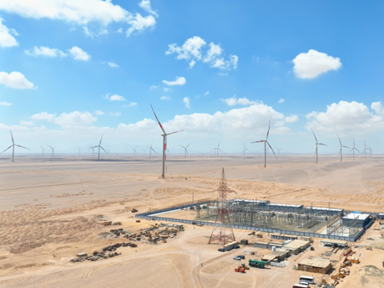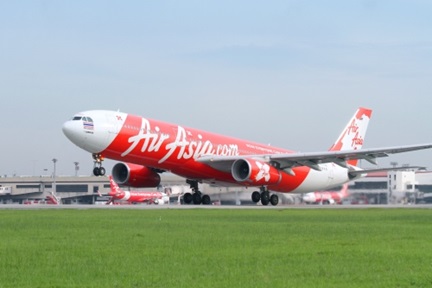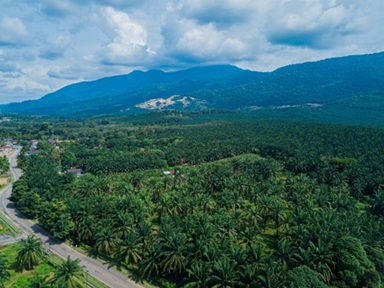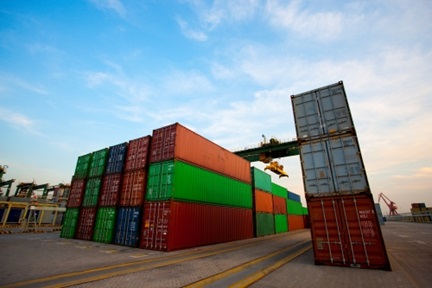Meeting the energy deficit in Africa
Africa is rich in oil, gas and renewable sources but more than half its people still have no access to electricity. The private sector can help plug the gap.
by Johan Burger

TRANSFORMING FLARE GAS INTO POWER FOR AFRICA
Although about 75% of the population in Sub-Saharan Africa lacks access to reliable or stable energy, Africa flares around 40 billion cubic meters (bcm) of gas annually, of which 35 bcm are at sub-Saharan Africa. This wasted gas can be used to bridge the power gap if investors step in.
Aggreko has developed end-to-end solutions that position them as the go-to provider for projects in Africa that use the flare gas to generate power. They have already completed a gigawatt of projects doing this. Aggreko is still evolving its offerings to minimise further the problems caused by flaring. The firm uses intelligent solutions that require little expertise or heavy financing arrangements. Aggreko’s model works by capturing gas that would typically be flared, piping it to a generator, then burning it to create electricity. While the generators produce modest emissions, these are far lower and less intrusive than produced by flaring and therefore reduce the pollution burden.
The flaring of gas will become far more expensive when governments adopt more robust clean air legislation and implement fines. However, with the right solution, such as Aggreko’s, it is possible to use flare gas to deliver cheap and stable power. The power is essentially free to the service provider. Aggreko uses a simple connection to a grid and gas treatment to remove impurities. After that, the system produces power that is competitive in price compared with traditional power infrastructure.
The flare gas-to-power model also addresses the future energy issue of climate change. Oil producers can now translate pollution into accessible power for governments, businesses, and the public. They can transform potential reputational blame into a reputational advantage. These are over and above the environmental benefits they can generate by turning a polluting waste by-product into a profit.[1]
POINT OF INTEREST
- To put the flare gas situation into perspective, 1 billion cubic metres of gas is equivalent to 6.6 million barrels of oil. Africa thus wastes the equivalent of 264 million barrels of oil by burning it off, while SSA wastes the equivalent of 231 million barrels. At the current oil price of about US$65 for Brent crude, this amounts to US$17.16 billion for Africa and US$15.015 million for SSA. This waste is more than the combined GDP of the bottom nine countries in SSA, at approximately US$13 billion. Until recently, lacking the necessary technology, this was an unavoidable waste. The technology now exists to make this wasteful exercise of gas flaring not only unnecessary but also profitable. With governments potentially on the verge of imposing fines for pollution, adopting flare gas to power will also save costs. The reality is that gas is not oil, but it also serves as a source of energy. With large parts of Africa without electricity, this source of energy can make a meaningful contribution. Lowering the price of this source of electricity will be difficult as producers would be cannibalising their main product unless they can ringfence the target market and focus on the bottom of the pyramid. The economic benefit of the flare to power model is that it would lower the average cost of production, theoretically allowing the producers to drop the average price of energy and still retain a similar profit. Hopefully, oil giants will do the right thing instead of focusing mainly on increasing their margins.
THE LACK OF MOVEMENT IN TANZANIA’S LNG SECTOR
Tanzania is struggling to benefit meaningfully from its oil and gas finds. The question arises as to why its oil and gas boom has yet to take off. Even the security challenges in Mozambique did not generate a positive spinoff for Tanzania. Up to 2010, Tanzania used its two (later three) mid-sized onshore gas fields for domestic purposes. However, following 16 discoveries from 2010 to 2015, Tanzania rapidly increased its aggregate gas reserves eightfold to more than 40 TCf.
Various large multinationals such as Norway’s NOC and the US-based ExxonMobil have interests in these fields. According to analysts, Tanzania’s favourable location vis-à-vis South and East Asia, i.e. the primary prospective market for its LNG exports, as well as its utilization of natural gas in electricity generation (accounting for roughly 50% of its electricity output), point towards a bright future for gas, provided the economics work for the offshore fields.
The international majors have shied away from committing to Tanzania’s LNG reserves. Tanzania’s challenges in developing its offshore oil and gas resources fall into three main groups: structural, psychological and technological. The structural challenges evolve around the competition between Tanzania’s LNG with Mozambique’s two concurrently developed LNG projects and the fact that Mozambique has so far outclassed its neighbour in terms of gas reserves in place. Mozambique also has the advantage of a more stringent and delineated set of upstream terms; it set participation by domestic National Oil Companies at 10% (Tanzania set it at 25%). The psychological effects hinge on the 3-year pause in offshore exploration drilling, aggravated by safety concerns linked to the pandemic.
From a technological perspective, Tanzania’s gas is more difficult to extract. While Mozambique’s reserves are found at moderate depths (1000-1500 metres), those of Tanzania are in ultra-deep water (2400 metres), leading to much higher extraction costs.
These developments do not mean Tanzania lost its opportunity to benefit from its LNG reserves. Should the authorities drop their insistence that oil companies’ adhere to Tanzanian law (disallowing any foreign court of justice), the current situation could change. Currently, the oil companies are concerned that upstream terms are vulnerable to arbitrary government changes. Should Tanzania’s government not take active steps to deal with the situation, its LNG sector will stagnate.[2]
POINT OF INTEREST
- Due to its lower carbon footprint, gas is increasingly popular as an intermediary source of energy in the transition from fossil fuel to renewable energy. The lack of progress in developing Tanzania’s gas reserves has been a source of concern for several investors who committed billions to exploit these reserves. Before the Magufuli administration, the government dragged its feet and failed to exploit its gas reserves. Despite high expectations, the situation did not improve under the Magufuli administration. With the poor security situation in Mozambique and the recent attacks in the Cabo Delgado province, Tanzania might have a window to renew the interest of the oil and gas majors in its reserves. This depends on the political will of the new Tanzanian government under President Samia Suluhu Hassan and its willingness to increase the ease of doing business in the country. The Tanzanian government is losing out on a significant potential source of new revenue and on providing more meaningful employment opportunities for its population.
PRIVATISING REFINING CAPACITY IN NIGERIA
According to the Major Oil Marketers Association of Nigeria (MOMAN), the Dangote Refinery will be hugely beneficial once it commences production. MOMAN has also advised the Federal Government not to limit the importation of refined petroleum products once the Dangote Refinery comes on stream to create an open market for the sector. MOMAN believes that free-market competition is the best protection for the final consumer.
A statement release by the Association says, “Anyone involved in the fuel supply chain, either as operators or regulators, must demonstrate cost optimisation in every practical and public way possible. In line with the recently launched Nigerian Upstream Cost Optimisation Programme (NUCOP), the industry must reduce costs for production, administration and governance throughout the petroleum value chain in the Nigerian petroleum sector, particularly downstream. Such a program will promote efficiency and competitiveness within the industry and ensure value creation for all consumers.”
Nigeria stills imports refined products despite being blessed with significant petroleum resources. The reality is that despite the building of the Dangote refinery, refining will not start in Nigeria immediately, as a result of many diverse and varied reasons.
According to MOMAN, Nigeria must track the progress of work at all the new refineries under construction across the country to ensure they are delivered timely, efficiently and sustainably. They also stated that should it be necessary, the sector must bring private investors on board to facilitate the rehabilitation and upgrade of the state-owned refineries. Better facilities will ensure the growth of Nigeria’s internal refining capacity and guarantee energy sufficiency for the country.[3]
POINT OF INTEREST
- Nigeria’s oil refineries have long been a source of grave concern and debate. The country has, until now, primarily exported its crude oil, only to import the refined products later on. This process loses out on higher revenues for value-added products and misses the opportunity to benefit from more meaningful employment opportunities. One major issue in the country’s oil industry is the poor condition of its state oil refineries. Their productivity levels at times reportedly amounts to a mere 10% of theoretical capacity. The government and the country might move to privatise the refineries and bring the private sector on board with better management and maintenance. However, the government shies away from adopting this option. Aliko Dangote built a private refinery with an annual refining capacity of 10.4 million tons (Mt) of gasoline, 4.6Mt of diesel and 4Mt of jet fuel, capable of refining 650,000 barrels of oil per day. The four state refineries have a collective theoretical capacity of 445,000 barrels per day. Should they one day operate at full capacity, Nigeria could refine one million barrels per day. By serving its demand instead of importing, the economy would benefit from import substitution. It could export the surplus to West Africa and even beyond into Africa. The benefits are self-evident.
KARPOWERSHIP IN SOUTH AFRICA
Karpowership from Turkey is a preferred bidder for South Africa’s Risk Mitigation Independent Power Producer Procurement Programme (RMIPPPP). The Programme will supply three power ships to address the country’s electricity supply challenges. South Africa’s Minister of Mineral Resources and Energy Gwede Mantashe reports that the vessels will feed power to the grid in three ports: Coega, in the Eastern Cape, Richards Bay in KwaZulu-Natal and Saldanha in the Western Cape.
The government released the RMIPPPP in August 2020 to alleviate South Africa’s electricity supply constraints and reduce the extensive use of diesel-based generators in the medium-to-long-term.
Powers ships are privately owned and operated floating power stations, which contain their complete sets of generation, electrical control, and substation components. The vessels also manage their maintenance workshop and engineering capabilities. The onboard substation can deliver power through connections to the national grid without lengthy delays or complicated engineering. The ships can operate both on liquid fuels (HFO/RFO) and natural gas. With high efficiency and availability, power ships can provide uninterrupted electricity at various high voltage levels.[4]
The value of the South African contract to Turkey’s Karpowership is R218 billion (±US$15.23 billion) with a term of 20 years. This contract term is the company’s longest to date. Liquefied natural gas will fuel the three vessels to provide 1,220 MW of electricity. This power will close a supply gap in South Africa that results in periodic blackouts. The Council for Scientific and Industrial Research in South Africa estimates the deal will cost as much as R10.9 billion annually (±US$762 million).
According to analysts, the long duration of the contract is an indication of the seriousness of South Africa’s power crisis, as well as a sign of its “questionable long-term planning in light of dropping renewables costs.” Karpowership will dock its powerships in South Africa around August of 2022.
According to Karpowership, they keep costs low through their reach into the LNG market and an exclusive, long-term deal with Shell.[5] Currently, only around 3% of South Africa’s energy mix involves LNG, which is cheaper than the diesel used to run Eskom’s Open Cycle Gas Turbines but far more expensive than coal.
Environmental groups have raised concerns about the continued use of fossil fuels. Researchers have warned that Karpowership’s 20-year contract could generate close to 20 million tons of carbon dioxide equivalent emissions per site.[6]
POINT OF INTEREST
- South Africa’s state-owned utility, Eskom, is unable to keep the lights on consistently and affordably. The government has now turned towards Turkey’s Karpowership for a long-term contract of 20 years. This conveys a clear message - Eskom is unlikely to sort out its capital equipment and management challenges anytime soon, despite what the government and Eskom itself regularly tells its citizens and consumers. In a recent development, it recently surfaced that Eskom’s procurement managers were colluding until very recently with private sector companies to fleece the company, continuing the corrupt practices at the company. For example, in March 2019, a buyer at one of Eskom’s power stations placed an order with a company for the refurbishment of two compressors to the value of R368,550 (US$25,781). It was later discovered that this company had sub-contracted another company to perform the work, which in turn sub-contracted yet another company, who then completed the job for US$2,895. Eskom further discovered that two completely new compressors would have cost only R112,000 (US$7,832). This is sadly only one example of many. The South African public and business sector end up paying the price for this situation.
Additional Readings
Anon. 2021. South Africa includes ‘power ships’ as part of its energy plans. BusinessTech. 19 March 2021. Available at https://businesstech.co.za/news/energy/477190/south-africa-includes-power-ships-as-part-of-its-energy-plans/. Accessed 18 April 2021.
Anon. 2021. Dangote refinery to be hugely beneficial for Nigeria, says MOMAN. Oil Review Africa. 5 March 2021. Available at https://www.oilreviewafrica.com/downstream/downstream/dangote-refinery-to-be-hugely-beneficial-for-nigeria-says-moman. Accessed 18 April 2021.
Bloomberg. 2021. Karpowership record S. Africa deal estimated at $15 Billion. Daily Maverick. 29 March 2021. Available at https://www.dailymaverick.co.za/article/2021-03-29-karpowership-record-s-africa-deal-estimated-at-15-billion/. Accessed 18 April 2021.
Daniel, L. 2021. Take a look: Floating stations coming to Saldanha, Richards Bay and Gqeberha. Business Insider South Africa. 19 March 2021. Available at https://www.businessinsider.co.za/take-a-look-floating-power-stations-coming-to-saldanha-richards-bay-and-gqeberha-2021-3. Accessed 18 April 2021.
Katona, V. 2021. Why Tanzania’s oil and gas boom isn’t taking off. Oil Price. 18 February 2021. Available at https://oilprice.com/Energy/Energy-General/Why-Tanzanias-Oil-And-Gas-Boom-Isnt-Taking-Off.html. Accessed 18 April 2021.
Morley, B. 2020. Solving the flare gas challenge in Africa. Oil Review Africa. Volume 15, Issue 6, 2020. Available at https://www.oilreviewafrica.com/aaccpp/DigitalMagDownload/ORA_6_2020.pdf#page=17. Accessed 18 April 2021.
References








